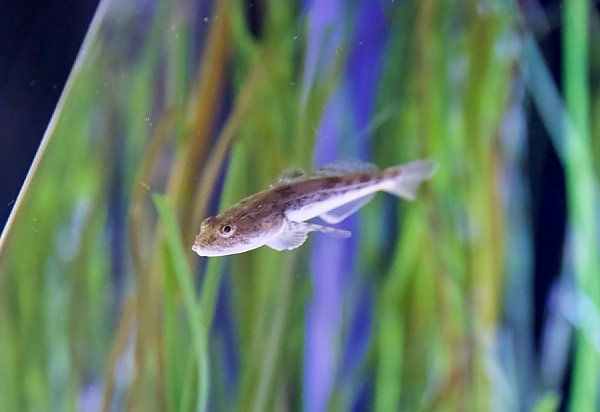Tidepool Sculpin
Oligocottus maculosus
Tidepool sculpins are small, fairly sedentary fish typically found in sheltered areas or tidepools in temperate waters. They have a large head with a tapering body, large dorsal and anal fins, and dark splotches on their backs. These sculpins have the ability to camouflage themselves by changing color to blend into the background and hide from predators. They are able to tolerate both ocean and brackish water. Tidepool sculpins have a small home area where they remain their entire lives. Should they be displaced from this area, they can find their way home using their keen sense of smell.

SPECIES IN DETAIL
Tidepool Sculpin
Oligocottus maculosus
CONSERVATION STATUS:
CLIMATE CHANGE:
At the Aquarium
Tidepool sculpins are on view in the oyster exhibit in Pacific Visions culmination gallery on the second floor.
Geographic Distribution
Tidepool sculpins are found in the North Pacific Ocean, from the Sea of Okhotsk and Bering Sea down the west coast of the United States to Los Angeles County, California.
Habitat
This intertidal temperate water species lives in sheltered areas and is typically found in tidepools. They are able to tolerate both brackish and normal ocean water.
Physical Characteristics
This small fish has a large head, tapering body, and large dorsal and anal fins. It is not as heavily spined as other sculpin species, with only a single spine on its jaw. It also has small tendril-like appendages called cirri on top of the head. Tidepool sculpins are splotchy, with colors varying from brown, grey, and white to possibly greenish or reddish and dark splotches on their back. They are able to change color to camouflage themselves. They are able to tolerate warmer water or water with lower salinity.
Size
Tidepool sculpins may grow to a maximum length of 3.5 inches (9 cm).
Diet
These fish feed on small invertebrates such as worms and small crustaceans.
Reproduction
Tidepool sculpins mature in approximately one year. Summer is their reproductive season. The males use their pectoral fins to hold the female while fertilizing the eggs as she is depositing them on a surface. Fertilization doesn’t take place until the eggs are laid in seawater. Females typically lay several batches of eggs each year. No further egg guarding or parenting is done. The larvae are planktonic. After thirty to sixty days, they move back into rock pools and become juvenile fish. Tide pool crowding may affect their growth rate.
Behavior
These fish are sedentary and solitary. If disturbed, they quickly propel forward with a snap of their tail to another hiding place.
Adaptation
Tidepool sculpins have a keen sense of smell. If removed from their home area, they are able to return to the area using their highly developed sense of smell.
Longevity
These fish may live up to five years.
Conservation
This species has not been evaluated by the International Union for Conservation of Nature.
SPECIES IN DETAIL | Print full entry
Tidepool Sculpin
Oligocottus maculosus
CONSERVATION STATUS:
CLIMATE CHANGE:
Tidepool sculpins are on view in the oyster exhibit in Pacific Visions culmination gallery on the second floor.
Tidepool sculpins are found in the North Pacific Ocean, from the Sea of Okhotsk and Bering Sea down the west coast of the United States to Los Angeles County, California.
This intertidal temperate water species lives in sheltered areas and is typically found in tidepools. They are able to tolerate both brackish and normal ocean water.
This small fish has a large head, tapering body, and large dorsal and anal fins. It is not as heavily spined as other sculpin species, with only a single spine on its jaw. It also has small tendril-like appendages called cirri on top of the head. Tidepool sculpins are splotchy, with colors varying from brown, grey, and white to possibly greenish or reddish and dark splotches on their back. They are able to change color to camouflage themselves. They are able to tolerate warmer water or water with lower salinity.
Tidepool sculpins may grow to a maximum length of 3.5 inches (9 cm).
These fish feed on small invertebrates such as worms and small crustaceans.
Tidepool sculpins mature in approximately one year. Summer is their reproductive season. The males use their pectoral fins to hold the female while fertilizing the eggs as she is depositing them on a surface. Fertilization doesn’t take place until the eggs are laid in seawater. Females typically lay several batches of eggs each year. No further egg guarding or parenting is done. The larvae are planktonic. After thirty to sixty days, they move back into rock pools and become juvenile fish. Tide pool crowding may affect their growth rate.
These fish are sedentary and solitary. If disturbed, they quickly propel forward with a snap of their tail to another hiding place.
Tidepool sculpins have a keen sense of smell. If removed from their home area, they are able to return to the area using their highly developed sense of smell.
These fish may live up to five years.
This species has not been evaluated by the International Union for Conservation of Nature.
